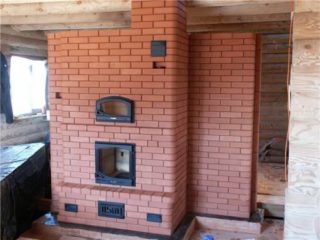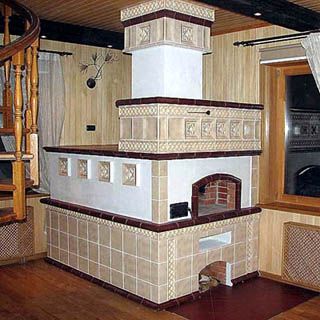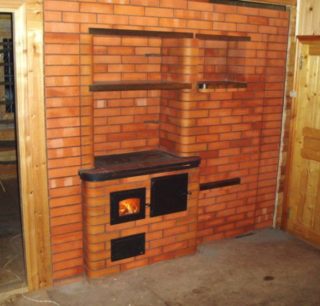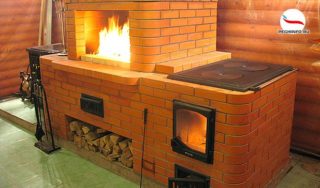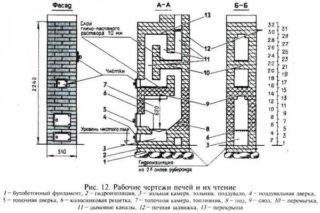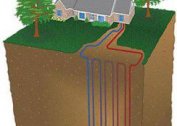The modern market has a wide variety of devices that can be used for heating a private house. Nevertheless, brick stoves for a wood-burning house do not lose their demand due to their multifunctionality, relative ease of maintenance and a cozy feeling of living heat. When choosing a design, you need to decide what functions it will perform and how much its installation is compatible with the internal structure of the house.
Varieties of brick stoves on wood
There are several common types of stoves. They differ in structural features, dimensions and functionality.
Dutch stove
The Dutch design is distinguished by the vertical placement of the channels, the walls are thinner than other varieties. Thanks to this, the walls of the room quickly warm up with hot smoke. Fuel does not burn, but smolders slowly inside. Due to prolonged burning, the need to load a new portion of firewood is less common. Long breaks between the furnaces do not lead to a decrease in power. For successful operation, the furnace must be regularly cleaned of ash accumulations and soot. Anyone who serves the Dutch must be able to kindle: the view must be kept closed, otherwise the walls will soon cool.
The unit has small horizontal dimensions (for example, models with a meter width and length are often found), while it can be of different heights. The small size makes this wood-fired brick oven suitable for a summer residence. She will be able to flood the room up to 70 m2. The high structure, passing through the ceiling, can serve a two-story house.
The Dutchwoman can be equipped with additional devices - a hob, an oven or a tank for heating liquids. Such a multifunctional installation is suitable for a country house in an area where there is no electricity, also serving as a stove and allowing you to cook steam and baked dishes, dry vegetables, mushrooms, berries. In the bath, it is better to install a small stone stove.
Russian stove
The largest option. The design has an open firebox, which is occasionally blocked by a shutter. In terms of versatility, this oven is not inferior to the Dutch woman and can be used for preparing hot dishes, baking bakery products, drying berries, vegetables, fruits and mushrooms. In addition, shoes can be dried on the stove; some models are equipped with a stove bench. When used in the summer for cooking, you need to open a special channel that communicates with the chimney. On it, the fumes are sent to the street. The oven can be painted or decorated with tiles. Not all materials are compatible with the unit in which high temperature is maintained.
The main disadvantage of this option is the bulky and massive design. The construction requires a solid foundation and large volumes of materials. Also, the furnace needs regular kindling and cleaning moves. If you do not heat the unit for a long time in the cold season, condensed moisture will begin to settle on the walls due to a temperature jump. Repeated absorption of this liquid by a brick does not lead to an improvement in its performance. Such material is prone to crumbling.
Due to the high cost of resources, the Russian stove is suitable for owners of private homes. For use in the country, it is better to choose a more compact model.
Swedish oven
Compared to the Dutch, the Swede has the best efficiency indicator and uses fuel more efficiently, but she will not be able to completely heat a two-story house. Its design is designed to service two rooms in the neighborhood. To heat the remaining rooms, you will need to install additional equipment. This stove is suitable for summer cottages.
The internal device has a system of several moves. The principle of operation is also similar to bell-shaped models when flue gases burn out under a furnace roof. The design of the furnace unit provides good floor heating. The swedish can be equipped with a fireplace, an oven, a hob, a compartment for drying things. The disadvantages include the need for materials with increased refractoriness for the manufacture of some parts (because of this, construction will cost more) and thermal insulation equipment that prevents heat loss in the lower part.
Area of use
By the criterion of the prevailing functional, aggregates are divided into several types. In addition to heating brick wood-burning stoves for the home, cooking and cooking-heating are also produced. Some models, in addition to these functions, are equipped with a fireplace, a tank for heating water or a contour installation for heating a larger area.
Models of strictly brewing purposes are usually used for a summer residence, to which owners come mainly in the warm season. If you put it in a residential building heated by gas or electricity, this will help to save the main, more expensive fuel. Typically, such devices have an oven and hob, sometimes equipped with a container for heating the liquid.
Units that combine the functions of heating the house and cooking can be used in a permanent home and in the country. Depending on the power of the stove and the dimensions of the room, it can be used as the only source of heating or combined with others.
The heating stove in the house or in the bathhouse is not equipped with an oven and hob. Some models have a fireplace and the option of heating the water. With proper placement, the stove can serve two or three rooms.
Advantages and disadvantages
Brick units are an attractive option for the ability to accumulate heat and slowly give it to the air and walls while maintaining a comfortable temperature value. With regular heating in the cold season, the house is maintained dry and warm.
Also, the advantages of brick ovens are:
- attractive appearance;
- ventilation of the room due to stove draft;
- the ability to cook, dry vegetable products, bake bread;
- a stove bench, as well as the option of drying things (on some models);
- Providing a source of fire in cases where it is required.
As a minus, it is necessary to indicate the inability of one unit to completely warm a large house. In this situation, it will be necessary to purchase additional heating equipment, for example, electrical appliances or a small stone stove, for placement in rooms that reach little heat.
Choosing a place to install the furnace
In a small dwelling, it is better to install the unit in the central zone, so that its walls are connected to several rooms and a kitchen at once. A Russian stove in this arrangement can work in 3-4 rooms.If a more compact model is used, it can be mounted so that the cooking and brass elements go out to the kitchen, and the back panel is built into the wall of one of the rooms, preferably closer to the border with the other.
Particular attention should be paid when installing stoves in wooden buildings. Since the material is flammable, it is imperative to strictly comply with building codes designed to minimize the likelihood of fire or other unpleasant incidents. Also, when choosing a place, it is important to ensure access to all parts of the structure so that there are no problems when cleaning and maintaining it.
Materials and tools for work
 Having decided on the location of the stove and having prepared a suitable design drawing, you can proceed with the acquisition of materials and tools. When calculating the number of bricks, they are guided by the selected masonry scheme and dimensions.
Having decided on the location of the stove and having prepared a suitable design drawing, you can proceed with the acquisition of materials and tools. When calculating the number of bricks, they are guided by the selected masonry scheme and dimensions.
Mandatory Tools
First of all, the master will need to prepare the sledgehammers to make holes and crack the brick bars. Also, pick hammers are useful for crushing and crushing pieces of material.
In addition, the following tools are required:
- trowel for coating surfaces with clay or concrete mortar and removing excess mixture;
- jointing for seams and grease seals;
- shovel for solution preparation;
- devices for tamping soil.
The seals work until the solution has frozen; in the process, the tool is constantly washed. To check the spatial parameters, you will need to purchase a square, building level, centimeter, rules of metal and wood.
Necessary materials
The main material used is red brick with high refractoriness. Since it is distinguished by its causticity, delivery should not be accompanied by shaking and other mechanical influences that could bring it into unsuitable condition. For laying the firebox fireclay brick is needed. The required number of elements is calculated based on the structure of the selected model. The solution is kneaded from clay - ordinary or with additives that provide greater refractoriness.
For construction, a number of cast iron elements are required: grate, firebox doors, cleaning section and blower, hob and latches. These parts are mounted on a steel wire frame. If the scheme provides for a water heater, the appropriate capacity is prepared in advance.
DIY building instructions
First, you need to equip the soil section under the stove. It is strengthened with rubble and then rammed. A little sand is poured on top, reinforced and the formwork is placed.
In the future, a step-by-step algorithm of the work will be as follows:
- If the furnace foundation was not made during the construction of the house, prepare it. The concrete composition is poured into the formwork and leveled. If the walls are made of wood, it is necessary to place insulating material on them, which prevents the throwing of fire. For this role, you can use stainless steel sheets, natural stone, asbestos, fire-resistant plasterboard products. It is important that the material does not emit harmful substances at high temperatures. When the concrete hardens, a roofing sheet protecting from moisture is laid on top.
- Brick is laid in rows in accordance with the scheme describing the selected design. In the absence of experience in this type of work, it is possible to lay out half of the furnace for training without using a solution, and only then proceed with the “finishing” operation. The evenness of the configuration in the process is measured by level and angles. It is necessary to lay bricks from the corner, the first of them closes the joints of the previous row. The solution is recommended to smear thinly and thoroughly tamp.
- When it will be necessary to lay a row where the grate is mounted and the door is blown, they are supposed to be reinforced with wire. A similar operation is done when installing a furnace door and grille. The niche located behind the grate of the furnace is filled with a solution. Do not forget that the furnace is made of fireclay or silicate brick.
- If the design implies the presence of a hob, you must carefully monitor when working with which series it is mounted. It must be placed on a corner of metal welded into the frame. Dimensions should correspond to those of the panel.
- Another task is to timely install a door for cleaning the oven and a water tank. The latter is placed on strips of steel.
- The smoke pipe can be made of stainless steel or the same brick that was used for the main structure. Its dimensions should correspond to those of a chimney hole equipped with a valve. Around the formwork is placed and concrete is poured there. A sheet of metal is nailed to the surface of the ceiling made of wood, through which the pipe goes. If the transition between floors is made, it is necessary to cover the pipe structure with material that ensures fire safety (usually mineral wool) and then lead it to the attic and then to the roof.
At the end of these works, the oven is subject to passive drying for a week. In this case, all valves and doors must be open. Then, during the week, dry drying with dry firewood is also carried out every day. The first procedure comes with 2 kg of fuel, the second and all subsequent ones - from 3-3.5 kg. At the same time, all doors except the firebox are left open. The process is considered completed when condensed moisture stops appearing on the doors a few hours after the procedure. Then you can load the stove with additional firewood. If cracks arose in the structure after a few months, they should be repaired.
A wood stove will provide warmth and coziness in the house, help in cooking and drying clothes. For quality work, the structure must be cleaned regularly. With a chimney, this operation is performed at least once a year.
